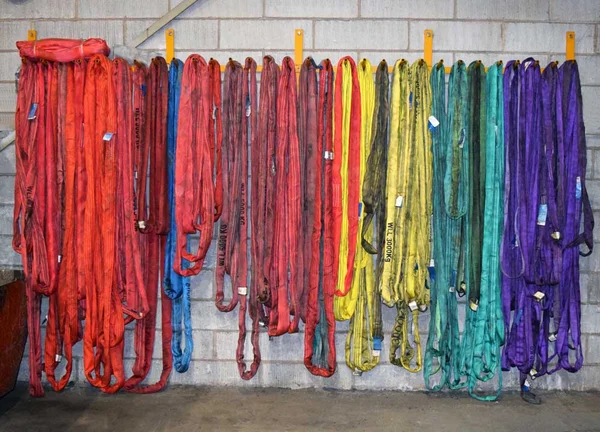
Synthetic slings can be washed
You can wash your synthetic CERTEX, POWERTEX and Extreema® round slings and webbing slings as long as you follow our washing instructions.
Washing
While it's best not to use a washing machine regularly, occasional washing (every 4-6 months) should be no problem.
Warning: Never use the centrifugation feature on the machine.
Water temperature
Use water with a maximum temperature of 40°C and a mild soapy detergent. After cleaning, allow the sling to dry naturally in a warm environment (room temperature) away from direct sunlight before use.
Regular hand cleaning to wipe away surface dirt and grease is preferred. Whenever required, rub a mild soapy detergent with a damp sponge on the affected area. Again, after cleaning/washing, allow the sling to dry naturally in a warm environment, room temperature, away from direct sunlight before use.

Warning: Never use alkali washing solutions.
Solutions of acids
Solutions of acids or alkalis that are harmless can become sufficiently concentrated by evaporation to cause damage. Contaminated slings should be taken out of service immediately, soaked in cold water, dried naturally, and handed to a competent person for examination.
If exposure to chemicals is likely, consult the manufacturer or supplier.
UV radiation
The man-made fibers from which the roundsling is produced are susceptible to degradation if exposed to ultraviolet radiation. Roundslings should not be stored in direct sunlight or near sources of ultraviolet radiation.
Contact with acids and alkalis
If lifting slings have come into contact with acids and/or alkalis, dilution with water or neutralization with suitable media is recommended before storage.
Depending on the material of the lifting sling and the chemicals involved, it may be necessary to request additional cleaning procedure recommendations from the supplier after the sling has been used in the presence of chemicals.
Storage of textile slings
When not in use, slings should be stored in clean, dry, and well-ventilated conditions, at room temperature and on a rack, away from any heat sources, chemicals, fumes, corrodible surfaces, direct sunlight, or other sources of ultraviolet radiation.
Slings that have become wet during the washing process or after cleaning should be hung up and allowed to dry naturally before further use.

Do you wish to know more? Please reach out.
For faster response, call us directly at +47 66 79 95 00!
Colour coding of textile slingsEver wondered why polyester slings come in different colors? This article explains the color coding system for textile slings. |
Learn more |
Criteria for rejecting textile slingsRound slings and webbing slings need regular inspections for defects and damage. But when is it time to discard them? |
Learn more |
Proper use of textile slingsHow should textile slings be utilized? Explore safe load handling techniques, coupling methods, proper storage, and safe lifting practices. |
Learn more |
Washing instructions of textile slingsIt might seem odd, but synthetic slings like round slings and webbing slings can be washed. Find out how here. |
Learn more |
What are the different types of textile slings?Lifting slings are available in various materials and strengths, so selecting the right sling for your specific lifting task is crucial. |
Learn more |
What is Dyneema®?What exactly is Dyneema®? Are all HMPE fibers identical? What makes HMPE unique? This article will provide answers to your questions. |
Learn more |


